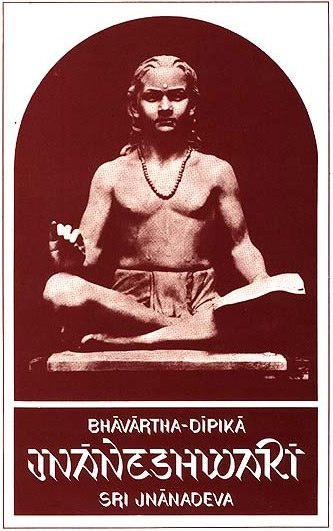Jnaneshwari (Bhavartha Dipika)
by Ramchandra Keshav Bhagwat | 1954 | 284,137 words | ISBN-10: 8185208123 | ISBN-13: 9788185208121
This is verse 6.12 of the Jnaneshwari (Bhavartha-Dipika), the English translation of 13th-century Marathi commentary on the Bhagavad-Gita.—The Dnyaneshwari (Jnaneshwari) brings to light the deeper meaning of the Gita which represents the essence of the Vedic Religion. This is verse 12 of the chapter called Dhyana-yoga.
Verse 6.12
Verse 6.12: “There, making the mind one-pointed, restraining all movements of the mind and the sense-centres, seated upon his seat, he should practise (Yogic) concentration for the attainment of the Self. (186)
Commentary called Jnaneshwari by Jnaneshwar:
Then sitting on that seat, the mind is to be concentrated by meditation of your preceptor with a view to self-realisation. This meditation on the master is to continue till the finer essence of pious love spreads through the entire compass of inward and outward being, and the hard inertia of egotism melts away, the sense-objects are forgotten, the restless anguish of the senses is calmed, the outgoing mind is lulled into a quiet within, and the quiet state of one still being settles down in the soul. One should abide in this sitting posture in this state of self-realisation. In this state, one begins to feel that his body automatically balances itself, while the life-breaths in the body hold together. In this state, the impulse towards activity turns back its face and lapses, while the state of rapt concentration of mind or the balanced state of mind comes to stay undisturbed, thus bringing the very means for the study of Yoga.
I shall now tell you, and do hear how the visible posture of the part of the body below the waist is to be fixed. The calves of the legs should make contact with the thighs, while the soles should be (made) flat and pressed against the bottom of anus. The right sole (under-surface of the foot) should be at the base and should press against the middle of the seam and the left one should automatically rest on the right one. There lies a space four inches between the anus and the testicles. Leaving an inch and a half on either side there remains a space of one inch in the middle. Against this should be pressed the heel (lower edge) of the right sole and the entire body is to be gathered up and held up balanced. The lower end of the back-bone should be raised so slightly that one should not even come to know that the upper half of the body (above the waist) gets raised up and sustained. Then, both the ankles should be raised and held hanging.
By this process, O Arjuna, the entire human (body) frame would remain suspended on the ankles. This is, O Arjuna, the description of the (Yoga) posture named “Mulabandha” which is called “Vajrasana” otherwise. When the upper half of the body remains balanced on the “Adhara-chakra” which lies in the middle of the anus and the testicles, the lower half gets pressed, and the life-breath called Apana in the intestines moves backwards towards the interior of the body.
